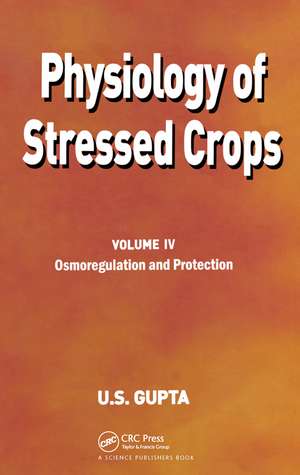Physiology of Stressed Crops, Vol. 4: Osmoregulation and Protection: Physiology of Stressed Crops
Autor U S Guptaen Limba Engleză Hardback – 8 ian 2006
Preț: 413.51 lei
Preț vechi: 531.64 lei
-22% Nou
Puncte Express: 620
Preț estimativ în valută:
79.12€ • 82.61$ • 65.49£
79.12€ • 82.61$ • 65.49£
Comandă specială
Livrare economică 14-28 martie
Doresc să fiu notificat când acest titlu va fi disponibil:
Se trimite...
Preluare comenzi: 021 569.72.76
Specificații
ISBN-13: 9781578084401
ISBN-10: 1578084407
Pagini: 244
Dimensiuni: 152 x 229 x 13 mm
Greutate: 0.61 kg
Ediția:1
Editura: CRC Press
Colecția CRC Press
Seria Physiology of Stressed Crops
ISBN-10: 1578084407
Pagini: 244
Dimensiuni: 152 x 229 x 13 mm
Greutate: 0.61 kg
Ediția:1
Editura: CRC Press
Colecția CRC Press
Seria Physiology of Stressed Crops
Public țintă
Academic and PostgraduateCuprins
Introduction to Osmoregulation: Introduction; Non-osmotic (Specific) Effects of Some Stress-induced Metabolits; Preconditioning; Osmoregulation and Environment; Inheritance of Osmotic Adjustment; Improvement Aspects; References; Measurement of Osmotic Adjustment; Suggested Readings�Inorganic Osmolytes: Introduction; The dominating role of potassium ion; K+-uptake mechanism; Sodium: Potassium uptake; The indirect role of calcium; Ion uptake as affected by different types of stresses; Improvement work; References; Brief descriptions of some procedures used; Patch-clamp method (Adopted from Lew, 1991); Suggested readings�Sugars � The Key Osmolytes: Freeze-induced dehydration; Drought-induced dehydration; Salinity-induced dehydration; Sugars and dehydration-induced ROS; Toxic ion (arsenic) stress; High light-intensity stress; Heat stress; Sucrose and stress metabolism; References; Some procedures used; Suggested readings�Complex Sugars � Cyclitols: Introduction; Cold stress; Salinity stress; Drought stress; Nutrient stress; The stress of ROS; Improvement work; References; Brief description of some procedures used; Suggested readings�Proline: Introduction; Proline biosynthesis in stressed plants; Localization and transport; Stressinduced proline accumulation and stress mitigation; Salinity stress; Drought stress; Cold and freezing stress; Improvement; References; Some procedures used; Suggested reading�Glycinebetaine: Introduction; Biosynthesis in stressed plants; GB-induced mechanism of stress tolerance; Subcellular localization of GB; Stress induced GB accumulation and stress mitigation; Drought stress; Salinity stress; Cold stress; Heat stress; Oxidative stress; Improvement; Variability; Genetics/ Inheritance; Metabolic engineering; Practical application and future perspective; References; Brief description of some procedures used; Suggested reading�Polymines: Introduction; Biosynthesis; Polyamines and root growth; Stress tolerance; Improvement; References; Method used; HPLC analysis of polyamines (After Hennion and Martin-Tanguy, 2000); Suggested readings�Trehalose: Introduction; Biosynthesis and sugar metabolism; Increased production of unstressed plants; Trehalose vs stress tolerance; Salinity stress; Drought stress; Improvement; Chloroplst vs nuclear engineering; Future perspective; References; Methods used; Detection of trehalose by HPLC with ELSD (Zhou et al., 2001); Trehalase assay (After Jang et al., 2003); Suggested reading�Fructan: Introduction; Biosynthesis; Abiotic stress tolerance; Hypoxia; Mineral nutrient stress; Salinity stress; Improvement; References; Suggested reading�Ectoine: Introduction; Biosynthesis; Transport; Engineering for ectoine production and improvement; References; Method used; Suggested reading�Citrulline: Introduction; Biosynthesis; Mechanism of Action; References; Method used; Suggested reading�ROS and Antioxidants: Introduction; ROS generation and ROS stress; The plant defence mechanism: Generation of ROS-degenerating enzymes and antioxidants; Enzymatic defence; Non-enzymatic defence; Stress induced ROS-detoxification by antioxidants; Cold stress; Heavy metal stress; References; Methods used (After Loggini et al., 1999); Suggested readings
Descriere
To cope with the abiotic stress-induced osmotic problems, plants adapt by either increasing uptake of inorganic ions from the external solution, or by de novo synthesis of organic compatible solutes acting as osmolytes. Of the osmoregulants and protectants discussed in this volume, trehalose, fructans, ectoine and citrulline, which are generated in different species, in osmotically ineffective amounts, mitigate the stress effects on cells/plants and improve productivity. There are several pieces of encouraging research discussed in this volume showing significant improvement in stress tolerance and in turn productivity by involving genetic engineering techniques.


